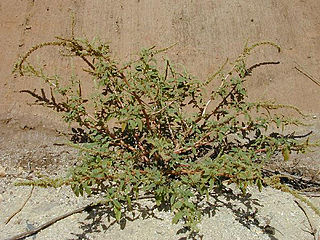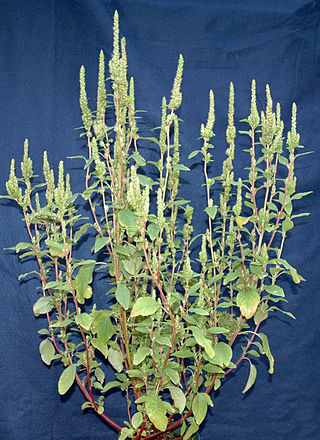
Amaranthus is a cosmopolitan genus of annual or short-lived perennial plants collectively known as amaranths. Some amaranth species are cultivated as leaf vegetables, pseudocereals, and ornamental plants. Catkin-like cymes of densely packed flowers grow in summer or fall. Amaranth varies in flower, leaf, and stem color with a range of striking pigments from the spectrum of maroon to crimson and can grow longitudinally from 1 to 2.5 metres tall with a cylindrical, succulent, fibrous stem that is hollow with grooves and bracteoles when mature. There are approximately 75 species in the genus, 10 of which are dioecious and native to North America with the remaining 65 monoecious species endemic to every continent from tropical lowlands to the Himalayas. Members of this genus share many characteristics and uses with members of the closely related genus Celosia. Amaranth grain is collected from the genus. The leaves of some species are also eaten.

Amaranthus blitum, commonly called purple amaranth or Guernsey pigweed, is an annual plant species in the economically important plant family Amaranthaceae.

Amaranthus viridis is a cosmopolitan species in the botanical family Amaranthaceae and is commonly known as slender amaranth or green amaranth.

Amaranthus caudatus is a species of annual flowering plant. It goes by common names such as love-lies-bleeding, pendant amaranth, tassel flower, velvet flower, foxtail amaranth, and quilete.

Amaranthus hypochondriacus is an ornamental plant commonly known as Prince-of-Wales feather or prince's-feather. Originally endemic to Mexico, it is called quelite, bledo and quintonil in Spanish.

Amaranthus spinosus, commonly known as the spiny amaranth, spiny pigweed, prickly amaranth or thorny amaranth, is a plant that is native to the tropical Americas, but is present on most continents as an introduced species and sometimes a noxious weed. It can be a serious weed of rice cultivation in Asia.

Amaranthus retroflexus is a species of flowering plant in the family Amaranthaceae with several common names, including red-root amaranth, redroot pigweed, red-rooted pigweed, common amaranth, pigweed amaranth, and common tumbleweed.

Amaranthus tricolor, known as edible amaranth, is a species of flowering plant in the genus Amaranthus, part of the family Amaranthaceae.

Amaranthus albus is an annual species of flowering plant. It is native to the tropical Americas but a widespread introduced species in other places, including Europe, Africa and Australia.

Amaranthus fimbriatus is a species of glabrous flowering plant in the Amaranthaceae family. It is commonly known as fringed amaranth or fringed pigweed. The plant is an annual herb that can often grow up to 0.7 m (2 ft.) in height. The flower is greenish to maroon. It is found in North America and in Mexico. It often grows on sandy, gravelly slopes, semideserts or in disturbed habitats. It usually blooms after the summer rains in these arid regions. It is considered to be an invasive weed.

Amaranthus cruentus is a flowering plant species that yields the nutritious staple amaranth grain. It is one of three Amaranthus species cultivated as a grain source, the other two being Amaranthus hypochondriacus and Amaranthus caudatus. It has several common names, including blood amaranth, red amaranth, purple amaranth, prince's feather, and Mexican grain amaranth.

The Coleophoridae are a family of small moths, belonging to the huge superfamily Gelechioidea. Collectively known as case-bearers, casebearing moths or case moths, this family is represented on all continents, but the majority are found in temperate areas of the Northern Hemisphere. They are most common in the Palearctic, and rare in sub-Saharan Africa, South America, and Australia; consequently, they probably originated in northern Eurasia. They are relatively common in houses, they seek out moist areas to rest and procreate.

Coleophora is a very large genus of moths of the family Coleophoridae. It contains some 1,350 described species. The genus is represented on all continents, but the majority are found in the Nearctic and Palaearctic regions. Many authors have tried splitting the genus into numerous smaller ones, but most of these have not become widely accepted.

Species belonging to the genus Amaranthus have been cultivated for their grains for 8,000 years. Amaranth plants are classified as pseudocereals that are grown for their edible starchy seeds, but they are not in the same botanical family as true cereals, such as wheat and rice. Amaranth species that are still used as a grain are Amaranthus caudatus L., Amaranthus cruentus L., and Amaranthus hypochondriacus L. The yield of grain amaranth is comparable to that of rice or maize.

Amaranthus blitoides, commonly called mat amaranth, prostrate pigweed, procumbent pigweed, prostrate amaranth, or matweed, is a glabrous annual plants species. It usually grows up to 0.6 m, though it may grow up to 1 m. It flowers in the summer to fall.

Zizeeria karsandra, the dark grass blue, is a small butterfly first described by Frederic Moore in 1865. It is found from the southern Mediterranean, in a broad band to India, Sri Lanka, the Andaman and Nicobar islands, Myanmar, Thailand, Malaysia, Yunnan, Indonesia, the Philippines, Arabia, United Arab Emirates, Saudi Arabia and Oman, New Guinea and northern and eastern Australia. It belongs to the lycaenids or blues family, and the tribe Polyommatini.

Amaranthus powellii is a species of amaranth known by the common names Powell's amaranth and green amaranth.

Coleophora versurella is a moth of the family Coleophoridae. It was described by Philipp Christoph Zeller in 1849.
Coleophora seminalis is a moth of the family Coleophoridae. It is found in Australia, New Guinea, Malesia, Fiji and eastern China.
Coleophora darwini is a moth of the family Coleophoridae. It is found on the Galápagos archipelago where it has been collected on Pinzón, Española, and Pinta islands.

















